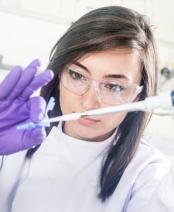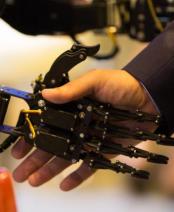Predicting tomorrow's antimicrobials

"Imagine if we were always one step ahead of the evolution of microorganisms and could anticipate each generation of treatment," says Julian Garrec, assistant professor at ENSTA Paris and researcher at UCP. This is the dream that Antires, a multi-disciplinary project bringing together scientists from the Laboratoire de biologie structurale de la cellule (BIOC**), the Laboratoire de synthèse organique (LSO***) of the École Polytechnique and the Institut de recherche biologique des armées (IRBA), could well bring to life.
To carry out their work, the project members are relying on Burkholderia pseudomallei. This bacterium, already closely monitored by the IRBA, is responsible for melioidosis, a potentially fatal disease well known to the military. The entire team is turning its spotlight on an enzyme involved indirectly (via the folate metabolic pathway) in the synthesis of the nitrogenous bases making up the microorganism's DNA, dihydrofolate reductase (DHFR). Here, antibiotic treatment consists of inhibiting the enzyme with a drug molecule occupying its active site - the cavity housing the chemical processes between the enzyme and its substrate - in place of the naturally transformed molecule.
Molecules in motion
The challenge is to identify the drug candidate that will best occupy this space and slow down the bacterium's reproduction. For the time being, R&D is focusing on docking. "This technique is based on an approximate, static assessment of enzyme-substrate or enzyme-drug interactions. The enzyme and the molecule that binds to it are treated as rigid entities. In reality, however, an enzyme system is a highly flexible, plastic and dynamic object. Docking's realism and predictive power are therefore very limited", explains Julian Garrec. Indeed, when the enzyme is in the presence of its substrate and a drug candidate, molecular dynamics mean that each element enters and leaves the active site more or less rapidly. Like a game of musical chairs, the substrate gives the drug several opportunities to take its place, and there is a strong interest in increasing the treatment's affinity for the active site. This is where Antires comes in, with its innovative interdisciplinary work in molecular modeling and prediction.
The team is digitally reconstructing the three-dimensional structures of wild-type DHFR (before mutation) and its substrate. Combined with the methods for modeling complex chemical systems rewarded by the Nobel Prize in Chemistry in 2013****, they have succeeded in describing in detail the molecular processes at play at the heart of the enzyme's active site. These approaches are an application of the laws of quantum mechanics and statistical physics to molecular systems. "We simulate how the atoms of the DHFR interact with those of the substrate or drug molecule, and we are able to measure precisely in silico the affinity between these protagonists and the enzyme", smiles the researcher.
So much for the first stage of the rocket. Antires scientists now want to couple these modeling techniques with an algorithm that would predict DHFR mutations when B.pseudomallei is subjected to antibiotic pressure. IRBA experiments have already revealed the mutant occurring in the presence of trimethoprim, for example. "We're keeping our fingers crossed that the algorithm we create will predict the same mutant. This will mean that our tool works. We'll then be able to anticipate a mutation in a pathogen when it's in the presence of a drug molecule", concludes Julian Garrec.
About :
Julian Garrec, teacher-researcher at ENSTA's process chemistry unit.
My research activity is centered around the use of computer simulations based on state-of-the-art Statistical Physics, Quantum Physics and Physical Chemistry to understand the behavior of various nanoscopic and subnanoscopic systems. This includes: solvated macro(bio)molecules (proteins, DNA and membranes), reactive systems in solution and in gas phase, gas hydrates and their interaction with potential promoters including small molecules as well as proteins.
*UCP: a research lab ENSTA Paris, Institut Polytechnique de Paris, 91120 Palaiseau, France
**BIOC: a joint research unit CNRS, École Polytechnique, Institut Polytechnique de Paris, 91120 Palaiseau, France
***LSO: a joint research unit CNRS, ENSTA Paris, École Polytechnique, Institut Polytechnique de Paris, 91120 Palaiseau, France
**** https://www.nobelprize.org/prizes/chemistry/2013/summary/














